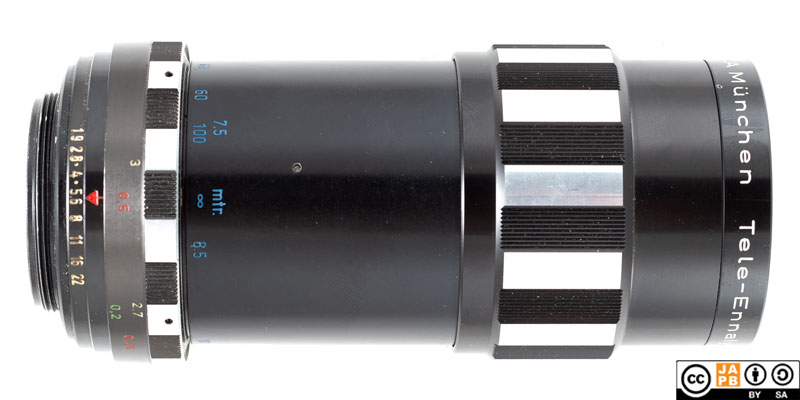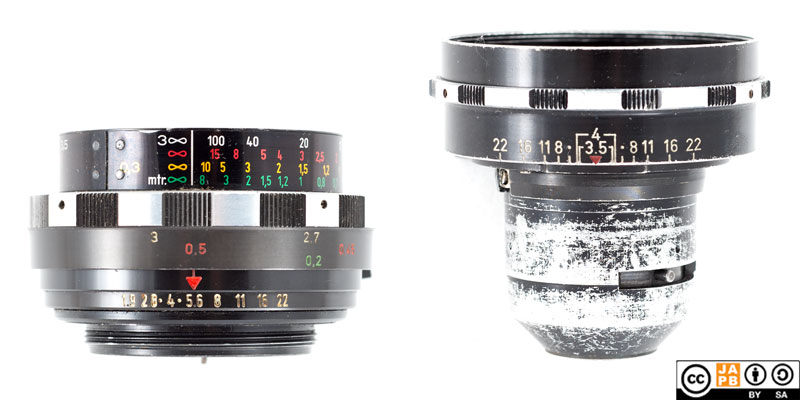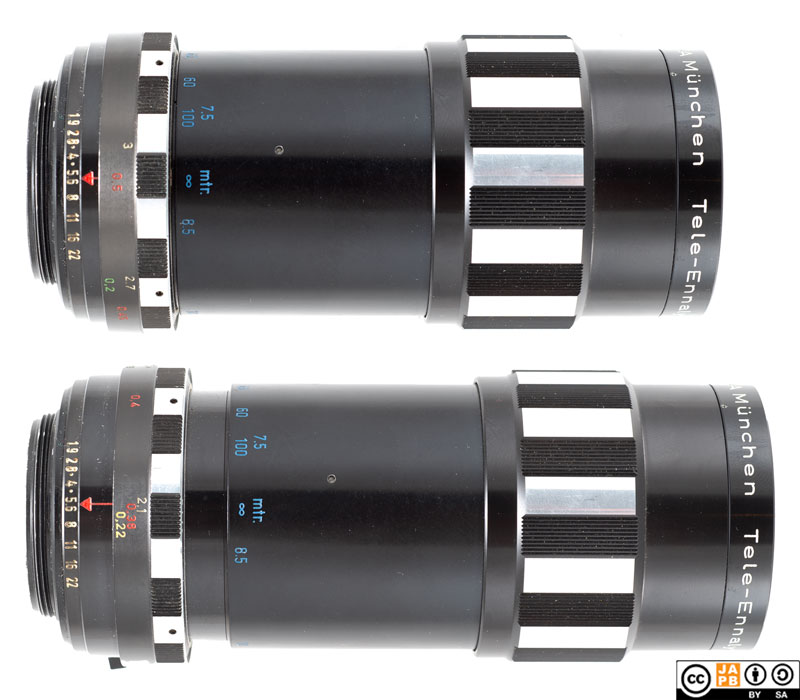Pekka Buttler, 04/2025 (Edited 6/25)

Specifications
The table below summarizes the lens’ key specifications (measurements based on pictured version of the lens):
| Brand: | ENNA München | Lens name | Tele-Ennalyt 1:4.5/240mm |
| Focal length(s)1 | 240 mm | Angle-of-view2 | ≈10 ° |
| Maximum Aperture | f/4.5 | In Production | 1958–1963 (this variant) 1958– (all variants) |
| Lens mount (this lens) | Enna Sockel (V1) | Mounts available through sockels | Exakta, M42, Praktina |
| Length (optical package) Length (with M42 Sockel)3 | 122,7 mm 128,0 mm | Diameter (optical package only) Diameter (with M42 Sockel)4 | 59,6 mm 62,6 mm |
| Filter ring diameter | 52 mm | Weight (optical package only) Weight (with M42 Sockel) | 452 grams 592 grams |
| Lens element count | 5 | Lens group count | 3 |
| Aperture blades (S/R/C)5 | 9 S | Focus throw | 530 ° 6 |
| Minimum focusing distance (measured) | 5,8 m | Maximum magnification (measured) | 1:21,7 |
| Has manual aperture ring | YES (on Sockel) | Has Manual focus ring | YES (on Sockel) |
| Aperture mechanism type | Semi-automatic | Aperture click stops | 3.5-4-5.6-8-11-16-22 |
Further notes:
• If you think 240 mm is an odd focal length for a tele lens, ENNA München clearly did not see it that way. In fact ENNA had a 240 mm tele lens in their product lineup from the late fifties all the way until the company quit the lensmaking business. During that time, the only thing that stayed the same were the lens’ mainline specifications: a focal length of 240 mm and a maximum aperture of f/4.5.
About ENNA Sockel lenses
• Unless you’re familiar with Enna Sockel lenses: Enna Sockel lenses are an early, advanced type of intermediate mount lenses, that are exceptional in that the lens is made up of two parts: The Optical package including the objective and diaphragm mechanism; and the Mechanical package including mount, Semi-automatic aperture control, and focusing helicoid. Read more in the JAPB article on the Enna Sockel.

Right: Optical package of the ENNA München Ultra-Lithagon 28 mm f/3.5 lens (this sample has lost some of its paint)
• One characteristic of the ENNA Sockel is that all lenses use the same focusing helicoid. While this is advantageous for the wide-angle lenses that gain extreme close-focusing abilities, longer lenses (like the 135 and 240 mm teles) do pay the price in terms of weak close-focusing abilities.

Notes on this data sheet:
• This data sheet makes use of a lot of data that was dug up in putting together the data sheet of the ENNA München Tele-Ennalyt 240/4.5 (M42). That data sheet was one of the most work-intensive in JAPB history.
• That work-intensiveness was primarily caused by the rather convoluted design history of the Enna 240 mm designs, in combination with that…
• Online sources have turned out to be quite much less in agreement than usual.
• You’re very welcome to send any and all details on 240 mm Ennas that you have lying around.
Versions and variations of ENNA’s 240mm f/4.5 lenses.
There have been (at least) three fundamentally different optical recipes: A 3 elements in 2 groups design that was able to cover medium format and a 5 elements in 3 groups design as well as a later 5 elements in 4 groups design that was used on 35 mm film cameras. The lenses have used (almost) every conceivable form of aperture, from manual to preset, to semi-automatic to automatic aperture. While M42 and Exakta clearly were the most frequently offered mounts, I have seen Enna 240/4.5 lenses offered in Leica thread mount, Praktina, Hasselblad 1000/1600 mount, QBM and T-mount.
While I have not been able to pin any timestamps on many of these, it is nevertheless possible for me to trace the general development of the various 240/4.5 designs as follows:
Version 1: Fluted body form (narrowest at mount, broadest at filter thread), broad zebra pattern, 527 mm filter ring, name on outside of lens (introduced ca 1958)
This is chronologically the first version of the Enna 240/4.5 lens.
It uses a 5 elements in 3 groups design8, and was offered in M42, Exakta and Enna Sockel (v1) as well as (more rarely) in Praktina and LTM mounts. Conflicting reports on aperture mechanism9.
Version 2: Tube body form with protruding rings (barrel stays roughly same diameter, but control rings extend out from the tube as if they were bracelets on a wrist), broad zebra pattern, 67 mm filter ring, name on name ring (introduced ca 1959)
This is chronologically the second version of the Enna 240/4.5 lens.
It uses a 3 elements in 2 groups design (a doublet at the front and a single lens at the back), making it a simplified classic tele lens (a positive group followed by a negative single lens). It is also a considerably larger lens than the first version.
Seemingly it was designed to cover the medium format frame, and it was sold with interchangeable mounts (samples with a Hasselblad 1000/1600 mount are regularly visible on eBay). Even though the idea was for it to be used on medium format, it seems most lenses were supplied with mounts for the usual 35 mm suspects (M42 and Exakta).
Based on serial numbers, all the manufactured samples originate from a single batch, so it’s safe to say that this was deemed a less than entirey successful foray.
Version 3: Fluted body form (narrowest at mount, broadest at filter thread), narrow zebra pattern, 52 mm filter ring, name on outside of lens (ca 1960-1964)
The third version of the Enna 240/4.5 lens.
It uses a 5 elements in 3 groups design10, and was offered in M42, Exakta and Enna Sockel (v2) mounts. In terms of shape this clearly the successor of version 1 (shape and dimensions are very similar).
Most lenses supplied for Exakta and M42 mounts are preset lenses, but unlike with version 1, some samples were produced featuring all the arrangements necessary to facilitate fully-automatic aperture on compatible bodies.
Version 3b: Fluted body form (narrowest at mount, broadest at filter thread), ribbed control rings, 52 mm filter ring, name on outside of lens (ca 1964)
The fourth (largely undocumented) version of the Enna 240 mm lens. The body form, ergonomics and barrel design seems identical to version 3, but the focus ring and aperture ring’s zebra patterns have been exchanged for a tight lengthwise ribbing. Was offered in at least M42 and Exakta mount as preset lenses, but based on very few samples more details cannot ve offered.
This is the last version of the 240/4.5 to proudly display its serial number.
Version 4: Tubular, svelte body form, ribbed control rings, 52 mm filter thread, name on outside of lens, body largely made of plastic (1964->)
The first modern body construction of the 240/4.5 Enna. All-black featuring the use of plastics for both aperture and focus rings (as well as other parts of the outer barrel.
Besides the extensive use of plastics, this lens differed from the previous versions in another important way: First, it ditched the 5 elements in 3 groups design for an even more compact 5 elements in 4 groups design.
Based on the samples I’ve seen I can state another few things:
– I have not seen a version with the Exakta mount. Given that I’ve only seen ca 20 samples this is no guarantee that it was never made in the Exakta mount, but is is a strong indicator of that the Exakta system’s star was waning. On the other hand, there seems to have been a custom batch manufactured sporting a T-mount.
– In contrast to all previous versions, the relative share of auto aperture equipped lenses rises to be the majority approach for the first time.
– All the samples I’ve seen have optics in a dismal state. It seems as if the coating used by Enna during this era was especially soft and liable to get ‘cleaning marks’ or then they were all used to photograph sandblasting world championships.
Version 5: Tubular, svelte body form, control rings with very fine pyramid texture, 52 mm filter thread, name on outside of lens, body largely made of plastic (likely 1970s ->) (See sample here)
All characteristics (except for the control ring pattern) as above.
Version 6: A black swan. Tubular, svelte body form, rubberised control rings with coarse rectangular pattern, 52 mm filter thread, multicoated, name on outside of lens, body largely made of plastic (late 1970s)
This is an odd duck in three respects. First I have only ever encountered one sample11, and it looks quite different from any other Enna lens. Second, unlike all the other 240/4.5 lenses, this lens is multicoated. Third, it features a Rollei QBM mount. Anyone who wants to shed more light on this lens should feel welcomed to do so.
History of ENNA München
ENNA München (also: Enna Werk München) is one of the 1950s and 60s most prominent and innovative German optics companies.
You can read more details in the ENNA München company profile.
Adapting the ENNA München Tele-Ennalyt 240 mm f/4.5
Adapting ENNA Sockel lenses
If you have an ENNA Sockel lens without a Sockel (meaning only an Optical package), then the only sensible way for you to adapt that lens is to procure an Enna Sockel of the same generation as your lens that offers a lens mount that you can work with (M42 and Exakta are likely the safest bets).
From then on:
Adapting M42 lenses
If you want to natively mount your M42 lens you need to find a functioning M42 mount film camera. Luckily that should be relatively easy as M42 bodies were produced in their millions and most of them lack features that are especially likely to have deteriorated to the point of making the entire camera inoperable.
Adapting M42 lenses to a mirrorless, full-frame digital camera is a breeze thanks to the lens having full manual controls (aperture ring, focus ring). You simply need a dumb adapter from M42 to your mirrorless system (but choose an M42 adapter with an internal flange, see more in the JAPB article on the M42 mount).
Due to the medium flange focal distance used by the M42 mount (45,46 mm), whether you can adapt this lens to dSLR/SLR mounts depends on which dSLR mount: Canon EF, Four Thirds, Minolta/Sony A and Pentax K can mount m42 lenses using a simple adapter ring. Nikon F on the other hand is not as problem-free, and – to retain anything near infinity focus – the adapter will necessitate corrective optics. In all cases, your camera will work only in stop-down metering.
Adapting Exakta lenses
If you want to use this lens in its native environment, you will need an Exakta-mount film camera body. Exakta bodies were manufactured in large numbers, and many of them are still in good shape. That said, you should take care to procure a workable sample.
Thanks to being a fully manual lens (manual aperture, manual focus), the lens can be adapted to all mirrorless cameras using a suitable adapter. Moreover, the Exakta lenses are so uncomplicated that a simple ‘dumb adapter’ will do the job perfectly. Furthermore, due to the popularity of the Exakta mount, special adapters (helicoid adapters, tilt/shift adapters) are readily available. Alternatively, one can choose to daisy-chain adapters (e.g. Exakta->Canon EF; Canon EF –> mirrorless) which also opens up a wide range of speed boosters .
Adapting Exakta lenses to dSLRs can also be an option, depending on which dSLR.
• Canon EF has the shortest flange focal distance among full-frame dSLR’s and Canon’s wide range of dSLRs are able to mount Exakta lenses perfectly using a simple adapter ring.
• Nikon F, Pentax K and Minolta / Sony A dSLRs need an adapter that uses corrective optics for Exakta lenses (the difference in flange focal distances is not enough to enable reaching infinity focus without corrective optics).
Footnotes
- Focal length is (unless stated otherwise) given in absolute terms, and not in Full-frame equivalent. For an understanding of whether the lens is wide/tele, see ‘Angle-of-view’. ↩︎
- Picture angle is given in degrees (based on manufacturers’ specs) and concerns the diagonal picture angle. Rule of thumb:
> 90 ° ==> Ultra-wide-angle
70–90 ° ==> Wide-angle
50–70 ° ==> Moderate wide-angle
40–50 ° ==> ‘Standard’ or ‘normal’ lens
20–40 ° ==> Short tele lens
10-20 ° ==> Tele lens
5-10 ° ==> Long tele lens
< 5 ° ==> Ultra-tele lens ↩︎ - Length is given from the mount flange to the front of lens at infinity. ↩︎
- Diameter excludes protrusions such as rabbit ears or stop-down levers. ↩︎
- S=straight; R=rounded; C=(almost)circular at all apertures. ↩︎
- Focus throw is a feature of the Sockel, not the lens. As Enna manufactured a range of Sockels and also kept doing minor tweaks, this value need not be accurate for every Sockel. ↩︎
- Some sources report the filter thread diameter as 67 mm, but the sample I have inspected has a 52 mm thread diameter. ↩︎
- This is not a Sonnar-type design, but rather a classic tele lens with two doublets at each end, but with an added positive lens element right after the front doublet. ↩︎
- Online accounts on the aperture mechanism in the M42 and Exakta mount versions differ, with some referring to it as a preset lens and others saying it’s a manual aperture with click stops (Rastblende). While I think it would be possible that Enna manufactured two versions, I’ll need more information on this. ↩︎
- Some sources indicate a 5 elements in 4 groups design, but I find the sources pointing towards a 5 elements in 3 groups design to be a bit more trustworthy. ↩︎
- https://www.ebay.de/itm/335397252748 ↩︎